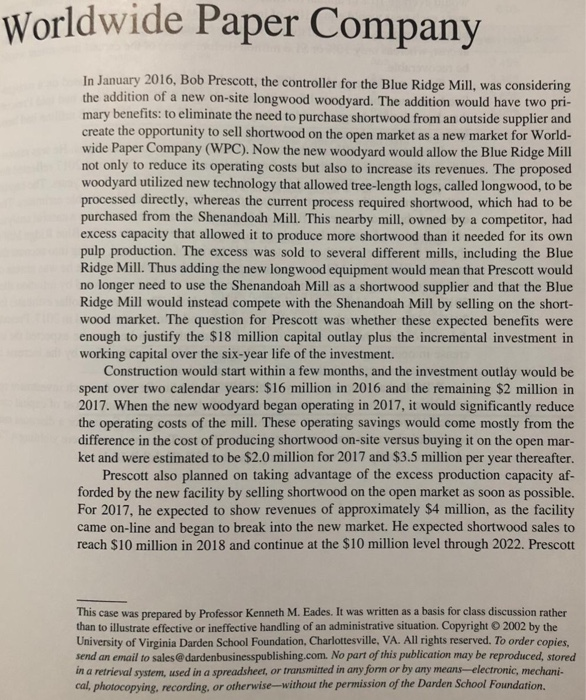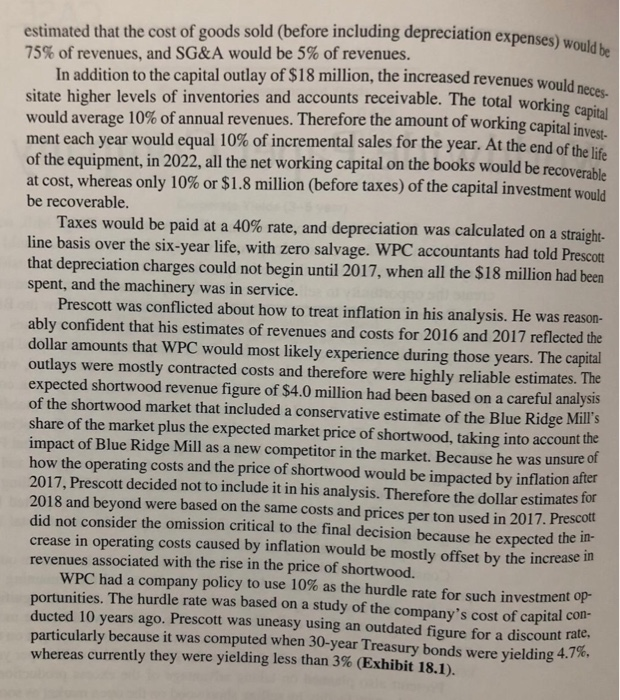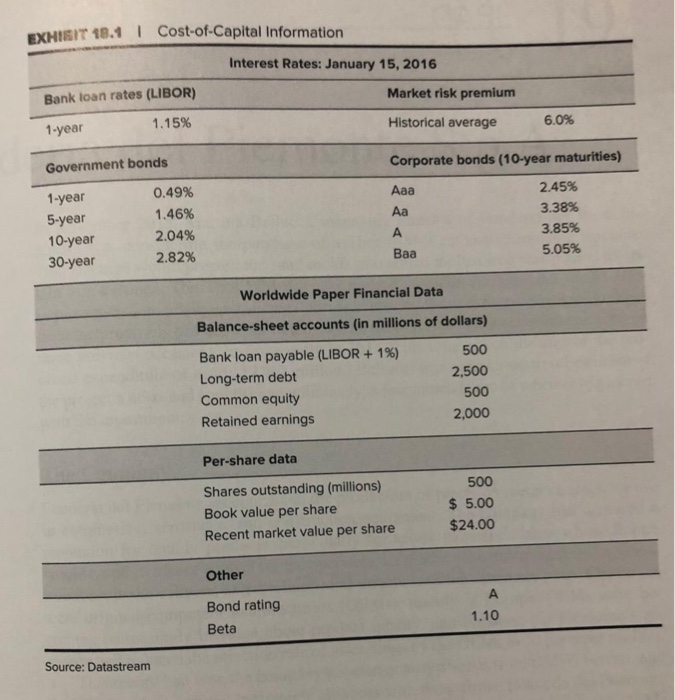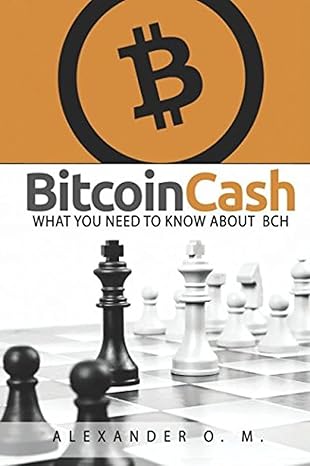Worldwide Paper Company In January 2016, Bob Prescott, the controller for the Blue Ridge Mill, was considerin the addition of a new on-site longwood woodyard. The addition would have two pri mary benefits: to eliminate the need to purchase shortwood from an outside supplier and create the opportunity to sell shortwood on the open market as a new market for World- wide Paper Company (WPC). Now the new woodyard would allow the Blue Ridge Mill not only to reduce its operating costs but also to increase its revenues. The proposed woodyard utilized new technology that allowed tree-length logs, called longwood, to be processed directly, whereas the current process required shortwood, which had to be purchased from the Shenandoah Mill. This nearby mill, owned by a competitor, had excess capacity that allowed it to produce more shortwood than it needed for its own pulp production. The excess was sold to several different mills, including the Blue Ridge Mill. Thus adding the new longwood equipment would mean that Prescott would no longer need to use the Shenandoah Mill as a shortwood supplier and that the Blue Ridge Mill would instead compete with the Shenandoah Mill by selling on the short- wood market. The question for Prescott was whether these expected benefits were enough to justify the $18 million capital outlay plus the incremental investment in working capital over the six-year life of the investment Construction would start within a few months, and the investment outlay would be spent over two calendar years: $16 million in 2016 and the remaining $2 million in 2017. When the new woodyard began operating in 2017, it would significantly reduce the operating costs of the mill. These operating savings would come mostly from the difference in the cost of producing shortwood on-site versus buying it on the open mar ket and were estimated to be $2.0 million for 2017 and $3.5 million per year thereafter Prescott also planned on taking advantage of the excess production capacity af- forded by the new facility by selling shortwood on the open market as soon as possible For 2017, he expected to show revenues of approximately S4 million, as the facility came on-line and began to break into the new market. He expected shortwood sales to reach $10 million in 2018 and continue at the $10 million level through 2022. Prescott This case was prepared by Professor Kenneth M. Eades. It was written as a basis for class discussion rather than to illustrate effective or ineffective handling of an administrative situation. Copyright 2002 by the University of Virginia Darden School Foundation, Charlottesville, VA. All rights reserved. To order copi send an email to sales@dardenbusinesspublishing.com. No part of this publication may be reproduced, stored in a retrieval system, used in a spreadsheet, or transmitted in any form or by any means-electronic, mechani cal, photocopying, recording, or otherwise-without the permission of the Darden School Foundation estimated that the cost of goods sold (before including depreciation ex 75% of revenues, and SG&A would be 5% of revenues penses) would be In addition to the capital outlay of $18 million, the increased revenues w sitate higher levels of inventories and accounts receivable. The total workin would average 10% of annual revenues. Therefore the amount of working capital ment each year would equal 10% of incremental sales for the year. At the end of th of the equipment, in 2022, all the net working capital on the books would be reco at cost, whereas only 10% or $1.8 million (before taxes) of the capital investment w be recoverable ould neces- invest- recoverable ould Taxes would be paid at a 40% rate, and depreciation was calculated on a straight line basis over the six-year life, with zero salvage. WPC accountants had told Prescot that depreciation charges could not begin until 2017, when all the $18 million had been spent, and the machinery was in service Prescott was conflicted about how to treat inflation in his analysis. He was reason the ably confident that his estimates of revenues and costs for 2016 and 2017 reflected dollar amounts that WPC would most likely experience during those years. The capital outlays were mostly contracted costs and therefore were highly reliable estimates. The expected shortwood revenue figure of $4.0 million had been based on a careful analysis of the shortwood market that included a conservative estimate of the Blue Ridge Mill's share of the market plus the expected market price of shortwood, taking into account the impact of Blue Ridge Mill as a new competitor in the market. Because he was unsure how the operating costs and the price of shortwood would be impacted by inflation after 2017, Prescott decided not to include it in his analysis. Therefore the dollar estimates for 2018 and beyond were based on the same costs and prices per ton used in 2017. Prescott did not consider the omission critical to the final decision because he expected the in- crease in operating costs caused by inflation would be mostly offset by the increase in of revenues associated with the rise in the price of shortwood. WPC had a company policy to use 10% as the hurdle rate for such investment op- portunities. The hurdle rate was based on a study of the company's cost of capital co ducted 10 years ago. Prescott was uneasy using an outdated figure for a discount ra particularly because it was computed when 30-year Treasury bonds were yielding 4.7 whereas currently they were yielding less than 3% (Exhibit 18.1) EXHISIT 18.1I Cost-of-Capital Information Interest Rates: January 15, 2016 Bank loan rates (LIBOR) Market risk premium 1.15% 1-year Historical average 6,0% Government bonds Corporate bonds (10-year maturities) Aaa Aa 1-year 5-year 10-year 30-year 0.49% 1.46% 2.04% 2.82% 2.45% 3.38% 3.85% 5.05% Baa Worldwide Paper Financial Data Balance-sheet accounts (in millions of dollars) Bank loan payable (LIBOR + 1%) Long-term debt Common equity Retained earnings 500 2,500 500 2,000 Per-share data Shares outstanding (millions) Book value per share Recent market value per share 500 $5.00 $24.00 Other Bond rating Beta 1.10 Source: Datastream 3. What discount rate should Worldwide Paper Company (WPC) use to analyze those cash flows? Explain your recommended rate and the assumptions that you used to estimate it. 4. What is the net present value (NPV) and internal rate of return (IRR) for the investment? How do you interpret these numbers










